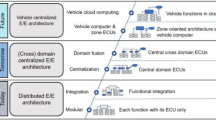Abstract
As vehicles become more intelligent, in-vehicle networking (IVN) systems such as controller area network (CAN) are essential for the convenience and safety of drivers. To expand the applicability of IVN systems, attention is currently being focused on chassis networking systems that require increased network capacity and real-time capabilities. FlexRay was developed to replace CAN protocol in chassis networking systems, to remedy the shortage of transmission capacity and unsatisfactory real-time transmission delay of conventional CAN. However, FlexRay network systems require a complex scheduling method, which is a barrier to their implementation as chassis networking systems. In particular, if we want to migrate from a CAN network to a FlexRay network using the well-defined CAN message database, which has been specifically constructed for chassis networking systems by automotive vendors, a new type of scheduling method is necessary to reduce scheduling efforts during the software development process. This paper presents a node-based scheduling method for easy migration from a CAN network to a FlexRay network system. To demonstrate the feasibility of the technique, its performance is evaluated in terms of various software complexity indices.
Similar content being viewed by others
References
Armengaud, E., Steininger, A. and Horauer, M. (2008). Towards a systematic test for embedded automotive communication systems. IEEE Trans. Industrial Informatics 4, 3, 146–155.
Cummings, R. (2008). Easing the transition of system designs from CAN to FlexRay. SAE Paper No. 2008-01-0804.
Jang, K. H., Park, I. S., Han, J. H. and Sunwoo, M. H. (2011). Design framework for FlexRay network parameter optimization. Int. J. Automotive Technology 12, 4, 589–597.
Kang, M., Park, K. and Jeong, M. K. (2013). Frame packing for minimizing the bandwidth consumption of the FlexRay static segment. IEEE Trans. Industrial Electronics 60, 9, 4001–4008.
Kim, M. H., Lee, K. C. and Lee, S. (2012). Expanding transmission capacity of CAN systems using dual communication channels with Kalman prediction. Int. J. Automotive Technology 13, 2, 301–308.
Kopetz, H. and Grunsteidl, G. (1994). TTP — A protocol fault-tolerant real-time systems. IEEE Computer 27, 1, 14–23.
Navet, N., Song, Y., Simonot-Lion, F. and Wilwert, C. (2005). Trends in automotive communication systems. Proc. IEEE 93, 6, 1204–1223.
Park, I. and Sunwoo, M. (2011). FlexRay network parameter optimization method for automotive applications. IEEE Trans. Industrial Electronics 58, 4, 1449–1459.
Rosset, V., Souto, P. F., Portugal, P. and Vasques, F. (2012). Modeling the reliability of a group membership protocol for dual-scheduled time division multiple access networks. Computer Standards and Interfaces 34, 3, 281–291.
Schmidt, E. G. and Schmidt, K. (2009). Message scheduling for the FlexRay protocol: The dynamic segment. IEEE Trans. Vehicular Technology 58, 5, 2160–2169.
Seo, H. S., Kim, B. C., Park, P. S., Lee, C. D. and Lee, S. S. (2013). Design and implementation of a UPnP-can gateway for automotive environments. Int. J. Automotive Technology 14, 1, 91–99.
Seo, S. H., Kim, J. H., Hwang, S. H., Kwon, K. H. and Jeon, J. W. (2012). A reliable gateway for in-vehicle networks based on LIN, CAN, and FlexRay. Trans. Embedded Computing Systems 11, 1, Art. No.7.
Sethna, F., Stipidis, E. and Ali, F. H. (2006). What lessons can controller area networks learn from FlexRay. IEEE Vehicle Power and Propulsion Conf., 1–4.
Sheng, Y. and Shijie, Z. (2010). A survey on metric of software complexity. The 2nd IEEE Int. Conf. Information Management and Engineering, 352–356.
Tindell, K. and Burns, A. (1994). Guaranteeing message latencies on controller area network (CAN). Proc. 1st Int. CAN Conf., 1.2-1.11.
Tu, H., Sun, W. and Zhang, Y. (2009). The research on software metrics and software complexity metrics. Int. Forum on Computer Science-Technology and Applications, 131–136.
Author information
Authors and Affiliations
Corresponding author
Rights and permissions
About this article
Cite this article
Kim, M.H., Lee, S. & Lee, K.C. Node-based scheduling method for easy migration from CAN to FlexRay in in-vehicle networking systems. Int.J Automot. Technol. 15, 953–959 (2014). https://doi.org/10.1007/s12239-014-0100-0
Received:
Revised:
Accepted:
Published:
Issue Date:
DOI: https://doi.org/10.1007/s12239-014-0100-0




